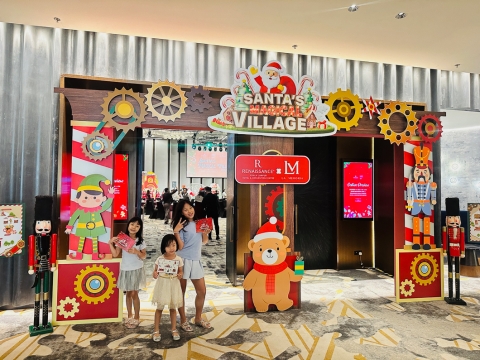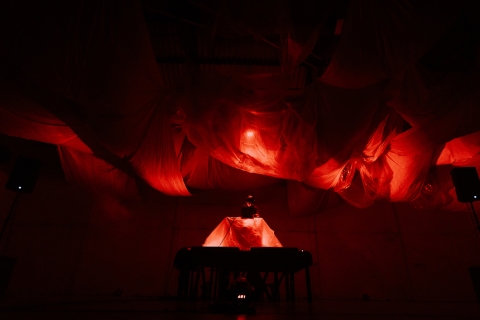What are the most valuable tools we can give our children now to ensure that they are successful in the future? In this article, Di McLean, Head Teacher at the Early Learning Centre of the Australian International School explores how education can help prepare children for what is ahead of them.
In a rapidly developing world, it is hard to predict what children will need to know in the future. What parents and educators do know is that students will need to develop divergent thinking skills, creativity and problem solving skills to be able to adapt to change and achieve successfully in the future. Developing the courage in students to take chances and to think outside the box, as well as to take assessed risks are important components of developing the divergent thinkers and problem solvers of the future.

Photo: Developing creativity through Performing Arts at AISM
Without trial and error there is no space for innovation. Children will also need to develop emotional intelligence and resilience to cope with mistakes and even failure. It will be important to be intuitive and flexible, to know when to make changes and how to adapt to make improvements.
Sadly, children seem to lose their creativity as they move through some school systems. The focus in many educational settings has shifted away from the process of finding out answers towards being told what to remember. Exploration, hands-on learning and creativity have been replaced by sitting at a desk; inquiry-based learning has been replaced with rote learning. This is having detrimental effects on young children and how they feel about learning.
Perfectionism and fear of failure can be debilitating for some students and may lead students to develop a fixed mindset. Children begin to fear getting things ‘wrong’ or making mistakes and as a result they begin to ‘play it safe’ with their solutions or answers or may choose to not even try at all. These children find it much harder to think creatively or to take risks for fear of getting something wrong. Teachers see this a lot in schools.

Photo: Science exploration from a young age at AISM.
There has been a significant increase in youth mental health issues and children having negative and fixed mindsets. This is especially true in the area of mathematics, where there is often one perceived correct answer. Consequently, this fear of making mistakes can be detrimental to student learning and, more importantly, on students’ wellbeing and happiness.
Why we need to nurture creativity and the beauty of trial and error?
At the Australian International School Malaysia (AISM), students are encouraged to increase their emotional resilience and their courage to try new things and to be willing to think outside of the box. For example, children are encouraged to try new activities at school when selecting their own activities from a choice of options. Rather than ‘playing it safe’, we teach children that ‘mistakes help you grow’ and that trying new things might help them find new interests.
It doesn’t matter if a student is not perfect at something straight away, but they do need to know that with hard work and persistence, one day they will get it right. This ongoing and powerful message is an important part of the process of learning and it cannot be found on a flashcard, worksheet or in a text book. Children need to know that mistakes are not the end of the world and that mistakes can, in fact, help them learn and adapt to build a growth mindset and a healthy and positive attitude towards school. And, after all, happy children learn best.
Developing creativity and problem solving-skills leads to children developing a positive growth mindset, understanding that with hard work and perseverance students can achieve their goals and reach their full potential. It also gives students a sense of ownership of their own learning process.
The Early Learning Centre at AISM for 3 to 5 year olds encourages children to explore and formulate their own questions through inquiry-based and Reggio Emilia inspired learning. Children learn by exploring topics in a hands-on context and learn or understand at a deeper level. Students are actively encouraged to explore, experiment, create and hypothesise.

Photo: AISM teachers encourage learning through discovery
AISM uses the Visible Thinking routines ‘What do I see?’, ‘What do I think?’ and ‘What do I wonder?’ to encourage children to notice connections, ask questions and create their own understandings – and making mistakes is an important part of this learning process. We encourage students to positively reflect on these important mistakes by using tools for reflection such as the thinking routine ‘I used to think… but now I think…’ and we celebrate new learning.
Students need to feel like they can take a chance and be prepared to be wrong in order to find out about things. This is real learning and these skills will continue to have a lifelong, positive effect on how they approach learning in the future.
Creating open minds, developing a positive growth mindset and encouraging curiosity and creativity will lead to developing the thinkers and leaders of tomorrow. This is an important and crucial shift in education.
Di McLean
Head Teacher – Early Learning Centre
Australian International School Malaysia
—
Find out more about AISM during Open Days,26 and 28 August, 10am-1pm
Prospective families who would like to visit and tour the school can make an appointment with the Admissions Department and Head of Schools on any working day. The school also organises regular Open Days with special talks and activities for parents and children. Click here to register now.
*This post is published in partnership with AISM. All photos by AISM.
Save
Save




















One Response
Most of the syllabus offered these days make education look too complicated. Education should have the right mixture of studies and creativity. A Great Post!